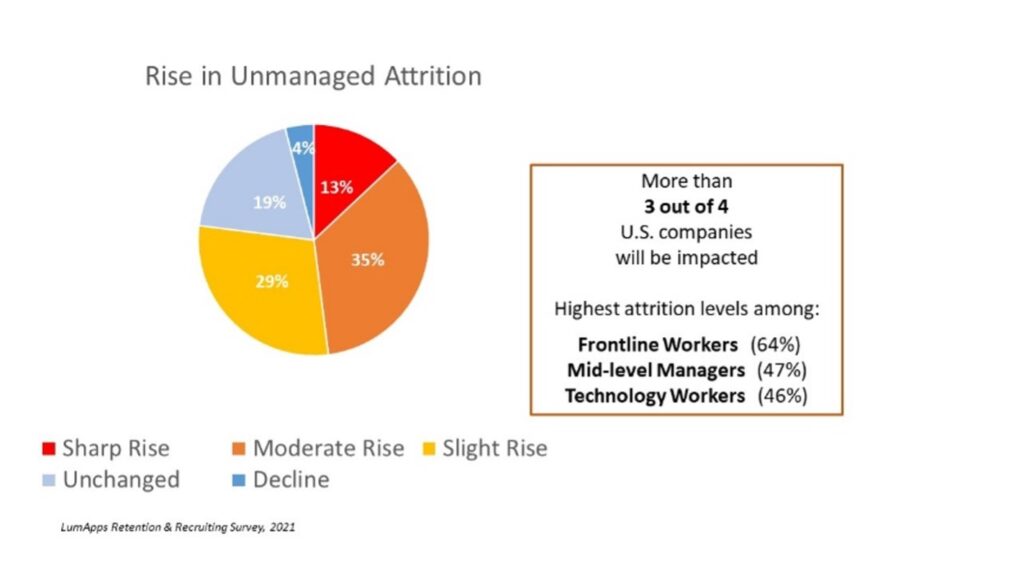The message is everywhere. Beware the Great Resignation! Some pundits interpret the statistics to say turnover rates aren’t that different from years past. Others proclaim the sky is falling and expect a collapse of business as we know it.
The truth lies somewhere in between. And the only truth that matters is what’s happening in your industry, company and team. That’s the only piece of the puzzle we can influence as executives, managers, supervisors and project managers. The best we can do is provide employees with a safe and engaging environment and the tools and resources they need to succeed.
It goes without saying these are challenging times. We have an ongoing pandemic, multiple generations in the workforce with their own unique perspectives and needs, economic pressures and a significant shift in the way people view work. There is a renewed emphasis on quality of life, doing work that matters and seeking growth opportunities.

The 2021 Lum Apps Retention and Recruitment Study identified burnout and work overload (often a direct result of attrition), a lack of interesting work, no growth opportunities and safety concerns about in-office requirements as the leading reasons for leaving an organization.
In January 2022, The Sloan Management Review identified the top five indicators of attrition as: a toxic culture, job insecurity, high levels of innovation, failure to recognize performance and poor responses to COVID-19. A toxic culture was reported to be more than 10 times more important than compensation, so throwing money into a bad environment will not stem the tide.
The combination of these conditions and concerns have created the necessity for organizations to reinvent their cultures. Many elements that used to be nice-to-haves are evolving into must-haves in attracting and retaining top talent. And it’s the top talent we are most afraid of losing. They are often the first to leave because they have options and are attractive to competitors.
Given the current circumstances, what can you, as a leader, do to repel the impact of the Great Resignation on your team and organization? There are five key areas to focus on to create or improve the appeal of your culture to potential candidates and top incumbents.
Respectful relationships
To create a sense of belonging, it’s critical to form strong and respectful relationships with all team members. That starts with showing a genuine interest in each person by making a personal connection and learning about them as individuals. The key is to concentrate more on the person and less on the task. That means taking whatever steps are necessary to preserve or enhance the relationship before worrying about the task at hand.
There is no one-size-fits-all style that will work with everyone. Whatever approach you take, it must be sincere. If your team member suspects you’re reaching out to them just to “check the box,” they won’t trust anything you say. However, if you are invested in their feelings and success, they will try harder to ensure you meet your objectives. When employees are invested in relationships throughout the organization, they feel connected and are less likely to consider outside opportunities.
Engagement
High employee engagement positively impacts key performance indicators ranging from customer satisfaction, profitability and innovation to employee retention and recruitment. Yet, organizations struggle to identify what environmental factors move the needle when it comes to sustained engagement versus temporary spikes in satisfaction.
As employees reexamine their career choices amid a global pandemic, economic pressures and work-life balance concerns, their expectations are shifting. Whether new candidates or seasoned professionals, the willingness to exert discretionary effort on their organization’s behalf is shifting. Those shifts are fueling the Great Resignation.
In response, many organizations have mistakenly implemented a slew of perks, in hopes of boosting engagement. While these efforts generate a short-lived feeling of goodwill, they do not address the most important needs and concerns of today’s employee.
For workers who crave recognition, supportive supervision, growth opportunities and the chance to make relevant and meaningful contributions, Zoom parties and pizza deliveries are not only insufficient, they become expectations rather than rewards. It’s important leaders address the underlying issues and make systemic changes to boost engagement levels instead of relying on band-aids.
Psychological safety
At its core, psychological safety is the feeling that you are accepted, valued and respected so you are comfortable sharing information or asking for help without fear of shame, blame or reprisal. When employees aren’t consumed with anxiety about how they will be perceived, they can devote more time to productivity, problem-solving and innovation.
While psychological safety is uniquely defined by each person, there are some common strategies. As a leader it’s important you:
- Set clear expectations
- Show empathy by accepting employees as they are
- Demonstrate respect and anticipate how remarks or actions might be interpreted
- Show appreciation for progress and achievements
- Resolve any misunderstandings or hurt feelings as quickly as possible
- Model desired behaviors
It’s up to everyone to create a sense of psychological safety. It’s incumbent upon leaders at all levels to intervene if they observe others violating these tenets. Psychological safety is easy to damage. All it takes is a thoughtless, off-the-cuff remark or some negative body language (eye-rolling, arm folding) to undermine an employee’s confidence and trust. Employees perform best and are more likely to stay put when they feel safe, appreciated and valued.
Empowerment
The days of command-and-control as a viable leadership model are gone. Today’s employee is more likely to respond to leaders who engage and enroll. Increase your employees’ control over the work they perform and how they perform it. Whether that’s flexible schedules that allow them to handle family obligations or encouraging them to innovate existing procedures, they crave autonomy. By increasing the tasks you delegate and the development opportunities you provide, you boost their skills and confidence.
When they can claim credit for their work and be recognized and appreciated, they gain a sense of relevance. They feel like active contributors rather robots carrying out rote tasks. They have a much greater sense of commitment to and investment in the organization’s continued success. As a result, they are less likely to search for other opportunities.
Leading with empathy and integrity
Let the change start with you and demonstrate the organization’s values. Don’t expect from others what you’re not willing to try yourself. You must talk the talk and walk the walk by modeling the desired behaviors.
If you show empathy towards your managers, they will show empathy to their employees. If you are willing to have difficult conversations, they can learn from your mistakes and model your successes when talking with their team. Often, your team will flourish with some added encouragement and those successes will boost their confidence and willingness to take on bigger challenges.
When you lead with empathy and integrity, you set the bar for everyone in the organization. Your actions speak volumes about what is valued and what won’t be tolerated.
This is where cultural change begins. Leadership decisions and actions form the foundation of creating an environment that attracts, nurtures and retains top talent. That’s how to repel the Great Resignation and improve the work environment in your organization.












